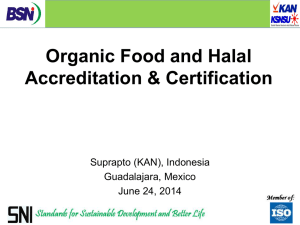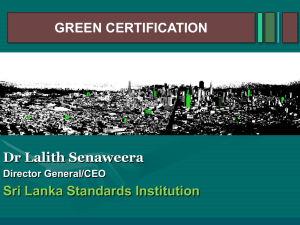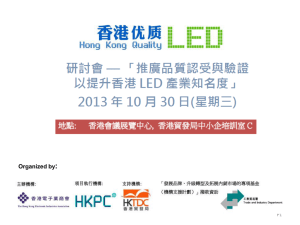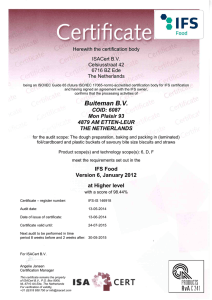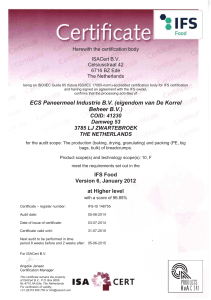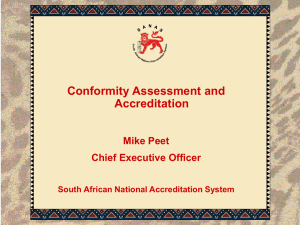Assessment schemes
advertisement
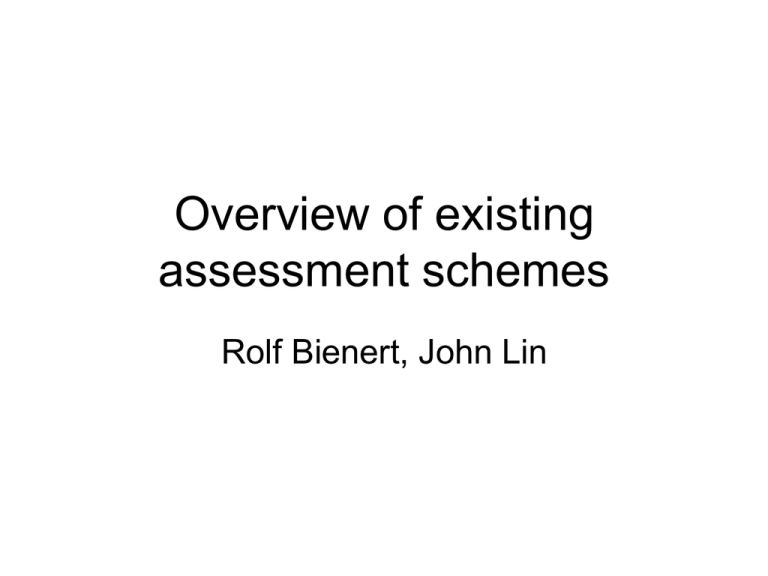
Overview of existing assessment schemes Rolf Bienert, John Lin Levels of assessment 1. 2. 3. 4. 5. Accreditation of assessment bodies Accreditation of test facilities Qualification of individuals Certification of systems Certification of products Accreditation of assessment bodies • E.g. ISO Guide 65 – ISO Guide 65 (or EN45011 as it is known in its European version) is the International Standards Organization guideline 'General requirements for bodies operating product certification systems'. It is a general guide for certification and has been referenced or used as a base for most organic norms and regulations (Europe, Canada, Japan etc) – ISO Guide 65 accreditation must be performed against a reference standard or standards. The reference standard may be the production and processing standards of a national regulation (often a national standard eg. European Regulation (EC) 834/2007) but may also be your own or another organization's private standard. IOAS accepts applications which reference to any organic standard or related area. Accreditation of test facilities • E.g. ISO 17025 – ISO/IEC 17025 is the main standard used by testing and calibration laboratories. There are many commonalities with the ISO 9000 standard, but ISO/IEC 17025 adds in the concept of competence to the equation. And it applies directly to those organizations that produce testing and calibration results. – There are two main sections in ISO/IEC 17025 - Management Requirements and Technical Requirements. Management requirements are primarily related to the operation and effectiveness of the quality management system within the laboratory. Technical requirements address the competence of staff, methodology and test/calibration equipment. – Laboratories use ISO/IEC 17025 to implement a quality system aimed at improving their ability to consistently produce valid results. It is also the basis for accreditation from an Accreditation Body. Since the standard is about competence, accreditation is simply formal recognition of a demonstration of that competence. – A prerequisite for a laboratory to become accredited is to have a documented quality management system. The usual contents of the quality manual follow the outline of the ISO/IEC 17025 standard. Certification of individuals • E.g. CISA (Certified Information Systems Auditor) Certification – There is a multitude of requirements for auditors out there. Most national and international accreditation agencies apply their own requirements. – Candidates have to show an understanding of the administrative and technical requirements – Documentation is key Certification of systems • E.g. ISO 9000 series – – – – Probably the best known accreditation scheme Small to large companies Customer service, product development, production Some requirements include: • a set of procedures that cover all key processes in the business; • monitoring processes to ensure they are effective; • keeping adequate records; • checking output for defects, with appropriate and corrective action where necessary; • regularly reviewing individual processes and the quality system itself for effectiveness; and • facilitating continual improvement Certification of products • Follows an industry accepted testing and certification scheme • Can be self-testing and self-certification • Most of the time – testing by third party (auditor, test facility, test organization, testing in group) & certification after review. Relevant Info • Example of assessment checklist for certification bodiese.g. what can be used to evaluate industrial certification organizations- from UKAS • http://www.itc.gov.hk/en/quality/hkas/doc/hkcas/HKCAS013-Checklist.pdf • Test Labs can be assessed to ISO Guide 17025 by A2LA • Checklist based on IEC/ISO Guide 65 can be modified by OpenSG with sector specific industry expert knowledge checks to augment assessment checklist for certification bodies (certification system conformity requirements from OpenSG- e.g. CPRM derived) 8





